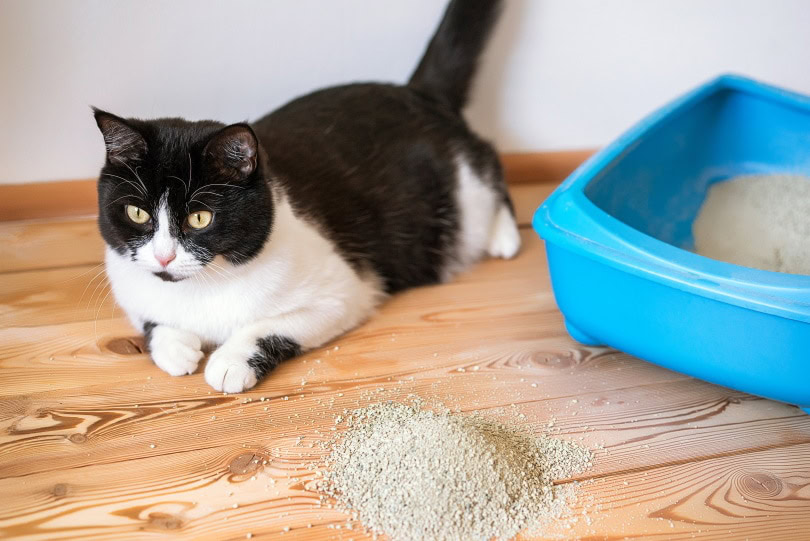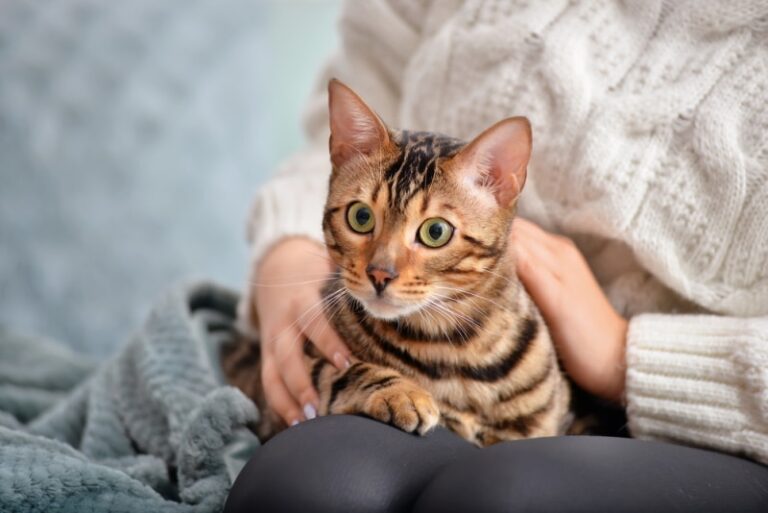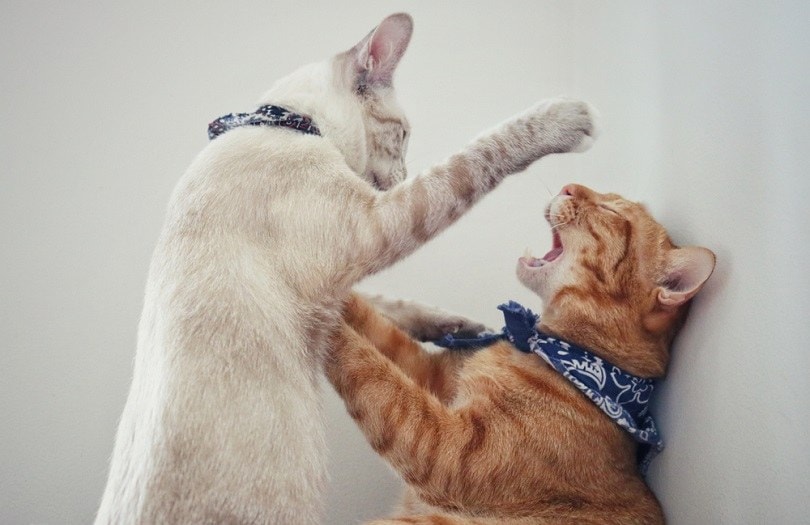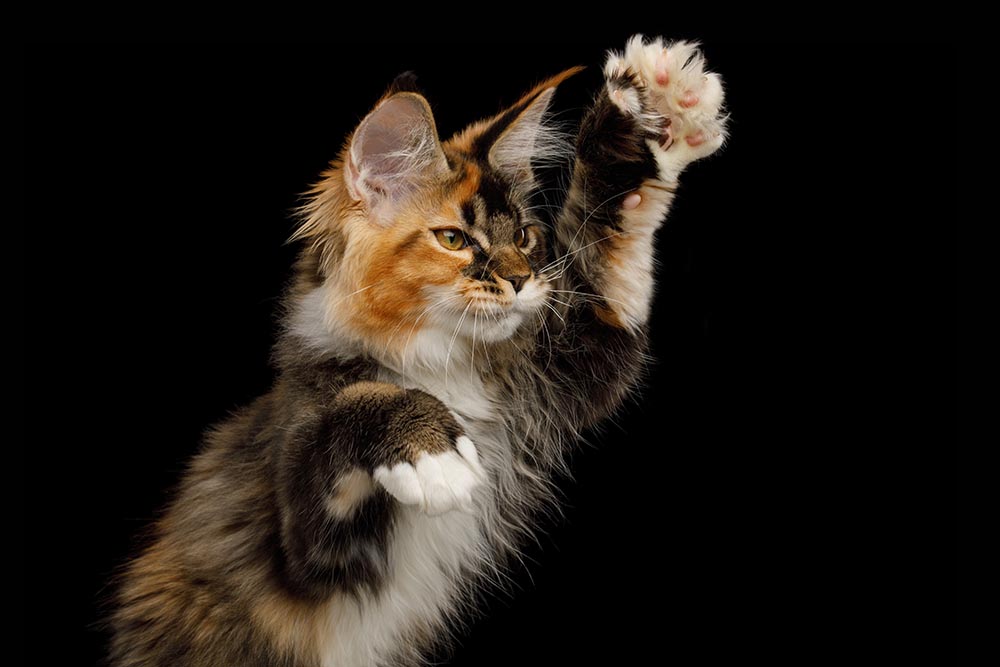VET APPROVED

The information is current and up-to-date in accordance with the latest veterinarian research.
Learn more »Click to Skip Ahead
Litter box problems are among the most common—and frustrating—cat behavior issues for owners. It can be challenging when your cat eliminates outside of the box. The first step in retraining your cat to use the litter box is to understand why your cat is going outside the box in the first place.
Important note: Changes in your cat’s urination habits may indicate serious medical conditions requiring urgent care, and therefore they should never be overlooked. Some urinary issues can pose significant risks to your cat’s health. Be alert to signs such as urinating outside the litter box, difficulty urinating, vocalizing while urinating, straining without success, unusual urine color, or increased frequency of urination. Seeking prompt veterinary attention is crucial to address these issues and avoid potentially life-threatening problems.

Why Do Cats Stop Using the Litter Box?
There are many reasons why a cat might stop using the litter box. The most important things to rule out are any potential health problems, like urinary tract issues or constipation.
Be sure to see your vet if your cat is showing signs of pain or distress, or is unable to urinate. Untreated urinary stones, plugs, crystals, or inflammation can lead to life-threatening blockages, especially in male cats.
Once you rule out physical causes, the problem may be very simple and easy to solve.
- Your cat dislikes a new brand or type of litter
- A dominant cat bullies a submissive cat in the box area
- The litter box is not cleaned often enough
- Your cat doesn’t feel comfortable going where you placed the box
- You have a multi-cat home with not enough litter boxes per cat
- A large cat (like a Maine Coon) has outgrown a standard size box
Observe your cat’s litter box behavior closely. After you’ve identified the most likely cause, how do you retrain your cat to begin using the box again?
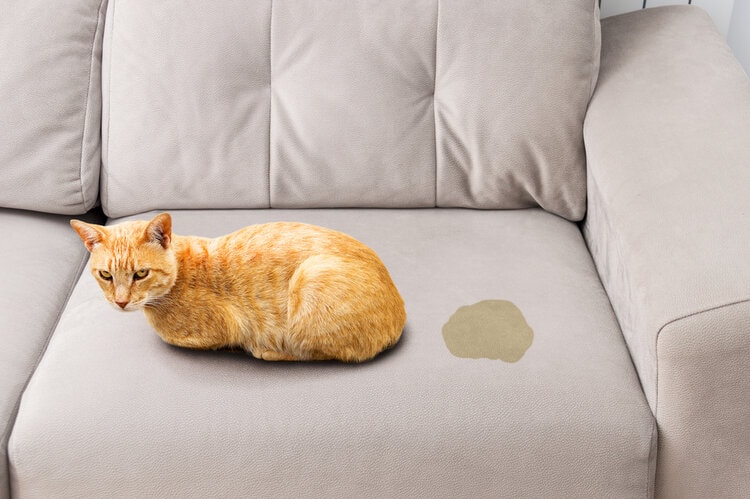
The 9 Easy Steps to Retrain a Cat to Use the Litter Box
Before You Start
Keep in mind that the problem, even as you work to solve it, might have caused your cat to develop negative associations with using the box.
Punishing or yelling at your cat for going outside the box can make those bad feelings worse, so avoid any negative reinforcements when accidents occur.
The key to retraining your cat to use the litter box again is to change those negative feelings into positive ones. Here’s how to make using the box comfortable again.
1. Find the Right Litter Box for Your Cat
A litter box should be 1½ times the length of your cat, measured from the nose to the base of the tail. Large cats need large boxes. For kittens and senior cats, the sides need to be low enough for easy access.
Have you switched from an open box to a closed box? Did you get a self-cleaning box recently? Your cat may prefer one box style over another.
And most importantly, get multiple litter boxes placed throughout the home in a multi-cat household. One box per cat plus one extra is ideal.
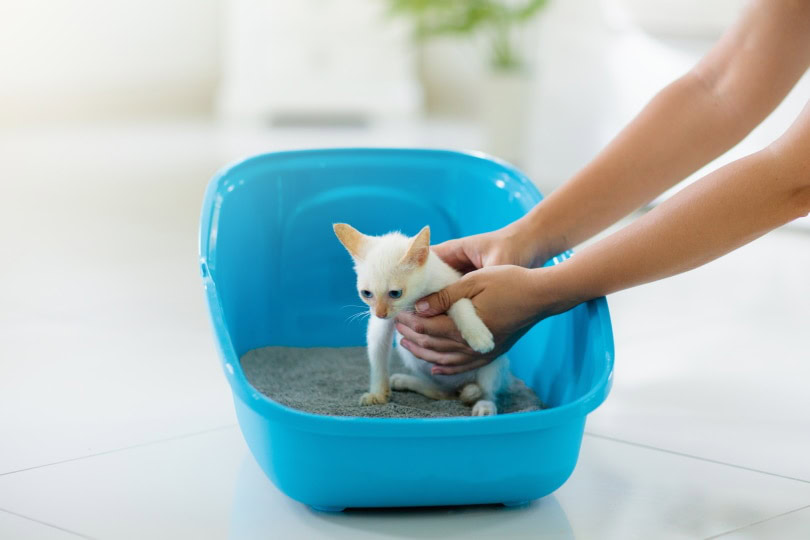
2. Find the Right Litter for Your Cat
There are many different types of kitty litter. Litter can be made from materials like clay, wood pellets, silica crystals, recycled newspaper pellets, walnut shells, and coconut husks, just to name a few.
Your preferred type of litter may not be your cat’s favorite. Sometimes a cat will develop an aversion to the texture of a particular kind of litter and prefer other surfaces like the carpet or a tile floor. You may have to experiment and purchase small containers of different types of litter until you find the right one. Every cat is an individual, but generally, cats prefer the feel of soft, finely textured litter.
Once you find the right litter, remember not to overfill or underfill the box. Too much or too little litter can sometimes be an issue. Ideally, aim for 2–3 inches of litter in the box.
No matter what kind of litter you use, bad smells often linger. That's where an effective litter additive like Hepper's Advanced Bio-Enzyme Cat Litter Deodorizer can make a big difference.
- Bio Enzymatic Cat Litter Freshener - Smart formulation uses natural ingredients eliminating cat...
- Save Money - Stuff for cats isn’t the cheapest. With this litter box odor eliminator, you’ll...
- Every Litter, Every Surface - Are you afraid this additive won’t work on your litter? Fear not!...
This biodegradable deodorizer is fragrance-free and safe for all ages of cats and types of litter. It uses bio-enzymes to naturally get rid of odors and help your litter last longer.
At PangoVet, we've admired Hepper for many years, and decided to take a controlling ownership interest so that we could benefit from the outstanding designs of this cool company!
3. Place the Litter Box in a Good Spot
Litter box placement is a crucial consideration, especially for a shy cat in a busy, multi-pet household or one living near neighborhood cats. If your cat is timid, put the box in an easily accessible but quiet place, away from heavily trafficked and noisy areas.
Avoid placing the box in an area where your cat will feel trapped or cornered if approached. Most cats like to see who’s coming and how they can escape if they feel uncomfortable.
Good litter box placement spots can include a basement or spare bathroom or bedroom. Poor locations are heavily trafficked areas such as the kitchen, a corridor, or spots near doors, windows, or the cat flap.
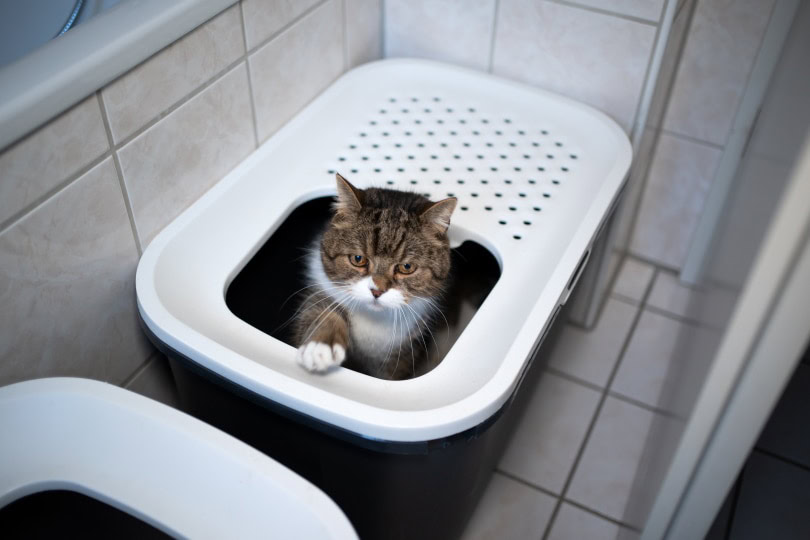
4. Thoroughly Clean Areas Your Cat Has Previously Soiled
It’s not uncommon for cats to return to a place in the home that they have soiled before. You can discourage this by removing any trace of the scent.
The best way to do this is with an enzymatic cleaner. Enzymatic cleaners are especially effective in cleaning urine. They break down the proteins and compounds in cat urine into different molecules.
Other types of cleaners may seem to us like they clean and deodorize well, but your cat’s sensitive nose will still detect the urine.
Our favorite enzyme cleaner is the Hepper Advanced Bio-Enzyme Pet Stain & Odor Eliminator Spray because it permanently removes even the very worst pet stains and smells you can imagine (and makes clean-up a breeze). They even offer a 100% satisfaction guarantee! Click here to order a bottle and freshen up your home today.
- ADVANCED ENZYMATIC CLEANER - Penetrates the most stubborn smells and stains at the deepest molecular...
- FOR ANY MESS, ON ANY SURFACE - This pet odor eliminator cleans your carpets, floors, furniture,...
- FRESH, NATURAL ODOR - Our unique formulation doesn't rely on dangerous or unpleasant chemical...
At PangoVet, we’ve admired Hepper for many years, and decided to take a controlling ownership interest so that we could benefit from the outstanding products of this cool cat company!
5. Keep the Litter Box Very Clean
Not surprisingly, cats prefer clean litter boxes over dirty litter boxes. Cleaning the litter box is not a fun chore, but it is essential, especially when your cat has litter box problems.
Scoop out the poop and solid clumps (if you use clumping litter) at least once per day. You can wipe down the sides if they are messy too.
Change the litter out completely at least once per week, but more frequently if necessary.
Wash out the litter box once every week using soap and water. Avoid harsh-smelling cleaning agents like ammonia.
Be aware that many cats do not like the feel of litter box liners, so it’s best not to use them.
6. Resolve Conflicts Between Multiple Cats
In multi-cat households, tension between cats is a common reason why one or more might stop using the litter box. Conflicts often arise when resources are limited, leading to behaviors like inappropriate urination or urine spraying as a form of stress or territorial marking.
To help retrain your cat to use the litter box, start by observing their interactions. Identify the social groups or subgroups in your household. Cats in the same group will groom, sleep, and play together, while those in separate groups may show aggression or avoid each other.
Providing enough resources for each cat is crucial. Ensure there are sufficient litter boxes (one per cat, plus one extra), along with separate food and water bowls, hiding spots, beds, and scratchers for all. In homes with active conflicts, separating these items—especially litter boxes—can significantly reduce stress and encourage every cat to feel secure enough to use the litter box consistently.
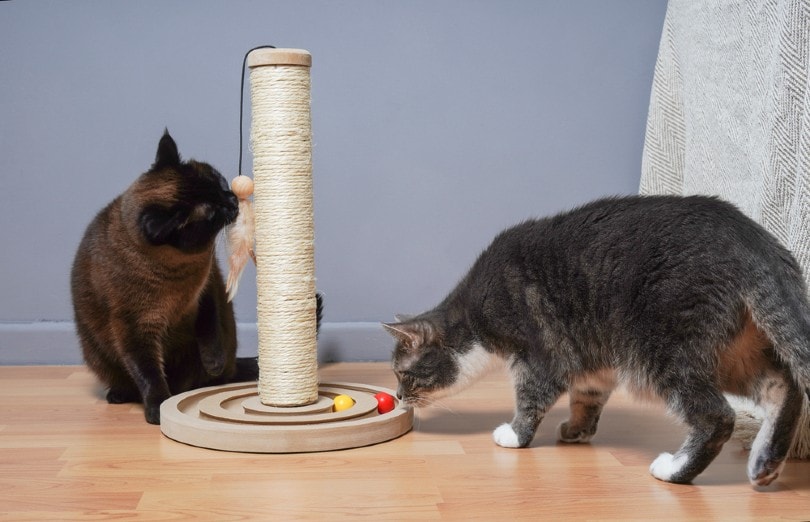
7. Try Stress-Relieving Pheromones
The use of pheromone sprays or diffusers has been proven to help create a more calming environment for your cat. These products mimic the natural pheromones cats release when they rub their faces on surfaces, which signals safety and comfort. Your best bet is to try stress-relieving pheromone sprays or diffusers in the litter box area. Placing a pheromone diffuser near the litter box area can help reduce stress and encourage your cat to use the box consistently.
Although some essential oils are marketed as calming agents for cats, we strongly recommend avoiding them. Cats lack the ability to metabolize many essential oils, and exposure can lead to toxicity.
8. Know the Difference Between Urine Marking and Going Outside the Box
Your cat will squat when urinating outside the box; a cat that scent marks their territory will stand with their tail high and spray behind them.
Urine marking is not the same as eliminating outside of the box. If you suspect your cat is spraying, it’s important to determine the cause. Possible reasons include attracting a mate, marking territory, communicating with other cats in the home, reacting to strays outside, or experiencing stress. One of the first steps to address this behavior is to have your cat neutered or spayed.
9. If All Else Fails, Seek Professional Advice
Sometimes a cat’s litter box and other behavioral problems can be tough to solve. Don’t be shy about talking to your vet or an animal behaviorist.
Your vet can prescribe medications for severe anxiety that may be contributing to your cat’s litter box issues. There are a variety of different drugs that you can try.
An animal behavior expert has training and experience in behavior modification techniques and can help you to better understand and work with your cat.
Look for Certified Applied Animal Behaviorists (CAABs) and Associate Certified Applied Animal Behaviorists (ACAABs), as they have advanced training in animal behavior, biology, and health.
Conclusion
Nobody likes when their cat starts urinating outside the litter box, especially because it can indicate a medical condition. Thankfully, there are plenty of solutions for this problem. However, always start with a visit to the vet to rule out any serious health issues.
Featured Image Credit: Tanya-Plotnikova, Shutterstock
